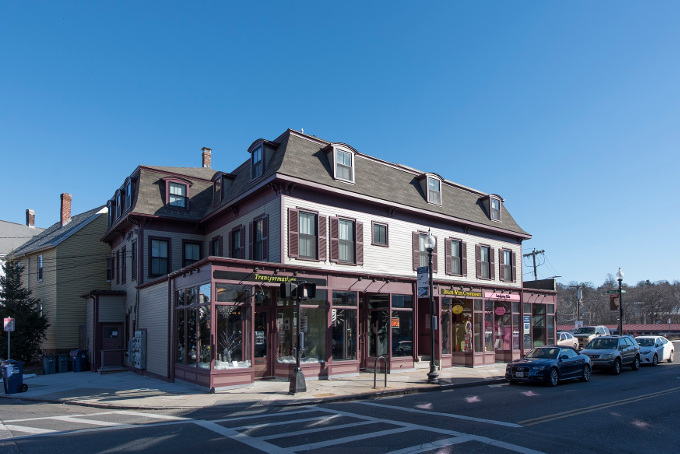
February 4, 2022 New preservation easement protects Vertullo Building’s future
Hyde Park’s Vertullo Building, one of the neighborhood’s earliest commercial building’s, will be preserved and protected in perpetuity after Historic Boston received State and local permissions recently to place a preservation restriction on the building before selling it to Nikia Londy and Barron Langston, business owners in the 1868 building.
You may be familiar with City designations of historic places such as listing on the “National Register of Historic Places,” designation as a “Boston Landmark” or “Landmark District,” all of which are usually designations placed and managed by government agencies. In Boston, the City’s Landmarks Commission can designate individual buildings and landscapes and whole districts as “Landmarks” offering them a high degree of protection in perpetuity. Future owners will plan repairs and changes in conjunction with written guidelines for the buildings, and must have them approved by the Landmarks Commission.
A variation on that is the preservation restrictions, also known as “preservation easements” or “conservation easements.” Federal law allows for preservation easements as a voluntary legal agreement to protect the property in perpetuity through a property’s deed. In addition to protecting the property, a donor of this kind of restriction to a non-profit preservation organization is also eligible for federal tax benefits for a charitable contribution.

In Massachusetts, various non-profit organizations accept donations of preservation restrictions. These include Preservation Massachusetts and Historic New England. Donations also typically come with a financial contribution to the non-profit recipient that is usually invested and, over time, helps to enforce the easement, particularly if there is ever a legal challenge to the protected property.
HBI will occasionally accept donations of historic preservation restrictions on significant historic properties in Boston, but the majority of HBI’s preservation restrictions are placed by HBI on properties that it has saved and restored before the organization sells the property, so that it can keep an eye on the significant investment made over time.
Brian Pfeiffer is an architectural historian who specializes in advising property owners on preservation restrictions and manages Historic Boston Inc.’s portfolio of restrictions. Annually, Brian conducts inspections of the buildings that HBI holds easements on. These are guided by descriptions of the building’s “protected features” as described within the easement legal instrument. What is he looking for? Generally, Brian’s inspections note changes and renovations that may not have been reviewed with HBI before installation, but mostly his work is preventative. Brian is looking to see if there are any maintenance issues that an owner must address before the condition of the building becomes dangerous to its preservation.
But most of the time, Brian’s work involves regular conversations with property owners where he helps to guide their planned repairs, helps to find them good contractors, and usually saves them a lot of time and money in addressing routine maintenance and undertaking capital improvements.
At the Vertullo Building, the only “protected features” are on the exterior of the building only, and include the form of the historic building and its historic features – storefronts, windows, cladding, roof and paint color. In the future, if a property owner wishes to improve or alter any of those features, HBI will need to review and approve those alterations. However, HBI does not want to preserve the building in amber. The easement will allow for additions and alterations to the building with HBI’s approval.
The Vertullo Building’s proposed restriction needed to be reviewed by the Boston Landmarks Commission, the City’s Assessing Department, and the Mayor’s Office before being voted upon by the Boston City Council. Massachusetts General Laws require those local approvals before the restriction is finally approved by the Massachusetts Historical Commission and then recorded with the property’s deed.
Other Historic Boston buildings with preservation restrictions on them included the Spooner Lambert House, the third oldest building in Roxbury; the Beaux-Arts Albany Building in the Leather District, designed by Peabody and Stearns; the marble-fronted row houses at 28-46 Cedar St. in Roxbury; and the Allston Congregational Church.
HBI looks forward to working with the Vertullo Building’s new owners on the care and preservation of the structure



